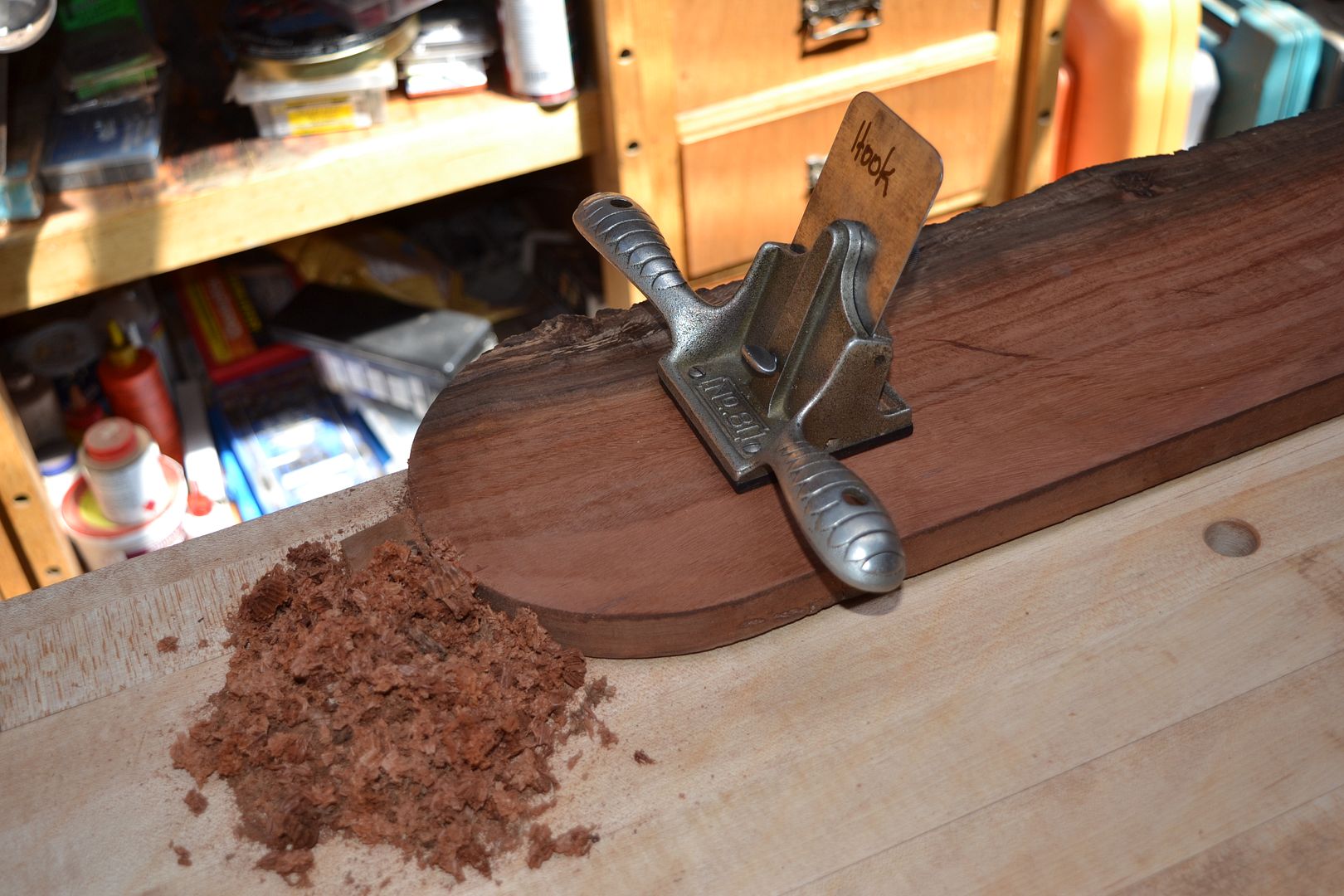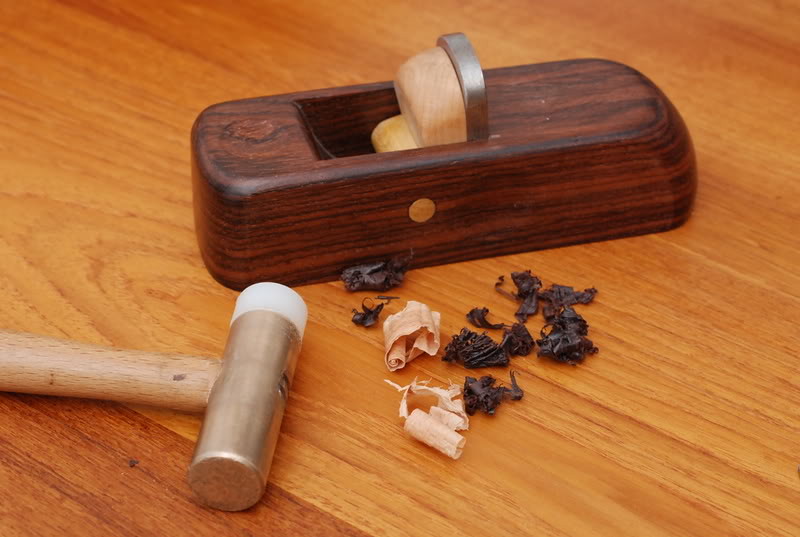No, I don't see the value in lifting an overturned burr with a point, but you can still use an awl to turn a regular burr on a tight inside radius.
You are using an out of date browser. It may not display this or other websites correctly.
You should upgrade or use an alternative browser.
You should upgrade or use an alternative browser.
Scraper planes
- Thread starter shed9
- Start date

Help Support UKworkshop.co.uk:
This site may earn a commission from merchant affiliate
links, including eBay, Amazon, and others.
swagman
Established Member
swagman
Established Member
D_W":csgt6viq said:It is a nice feature, and extends the time between burr reset, at least in large work (table tops, etc).
David; its also allows you to manipulate the width of shaving. Below is a view of the modified Stanley #81 with the lever cap removed.
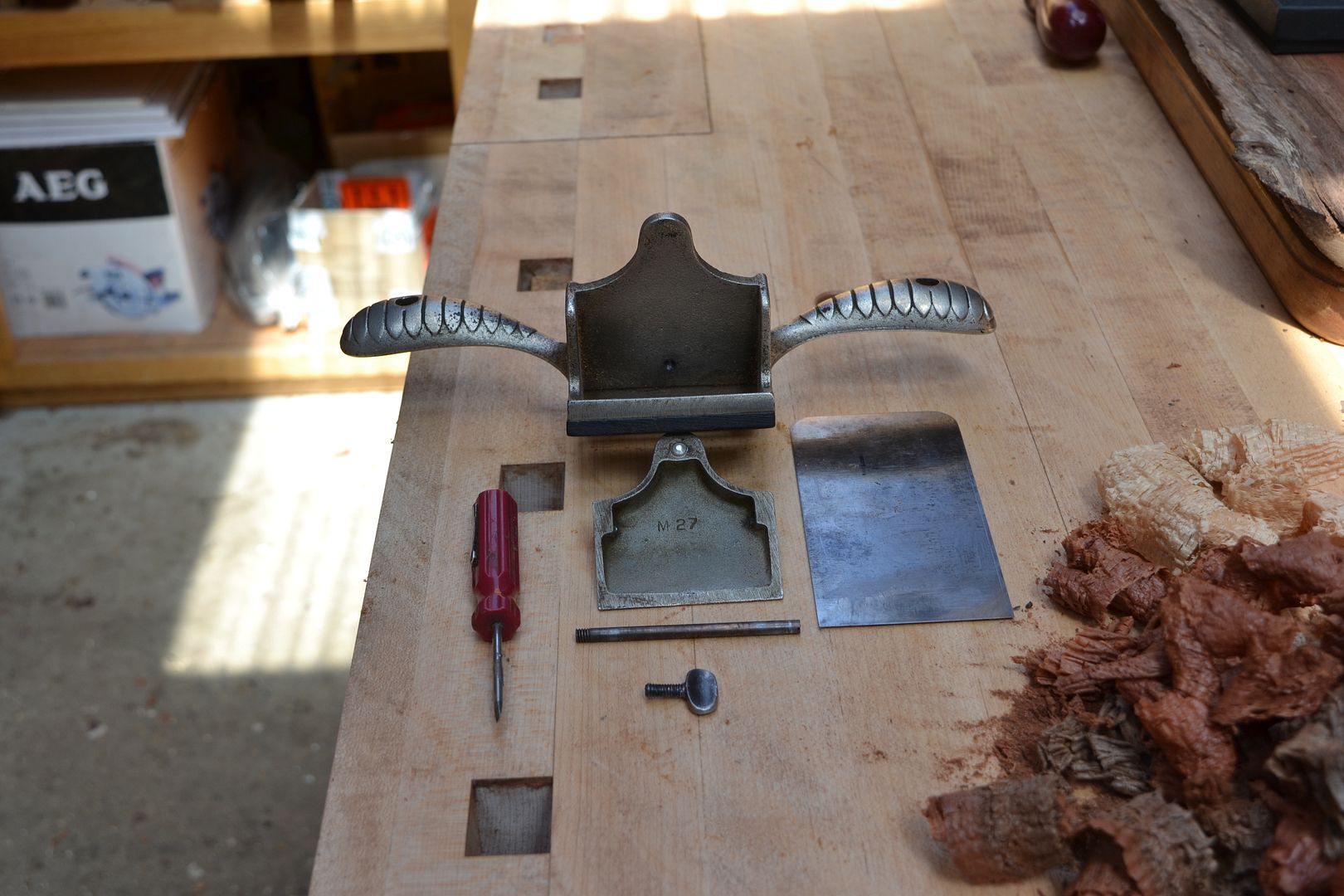
I have also made a change to the way I prepare the burr before turning a hook with the burnisher. It is quite different to the methodology you outline within your video.
This change in practice has achieved a noticeable difference in the type of shaving taken.
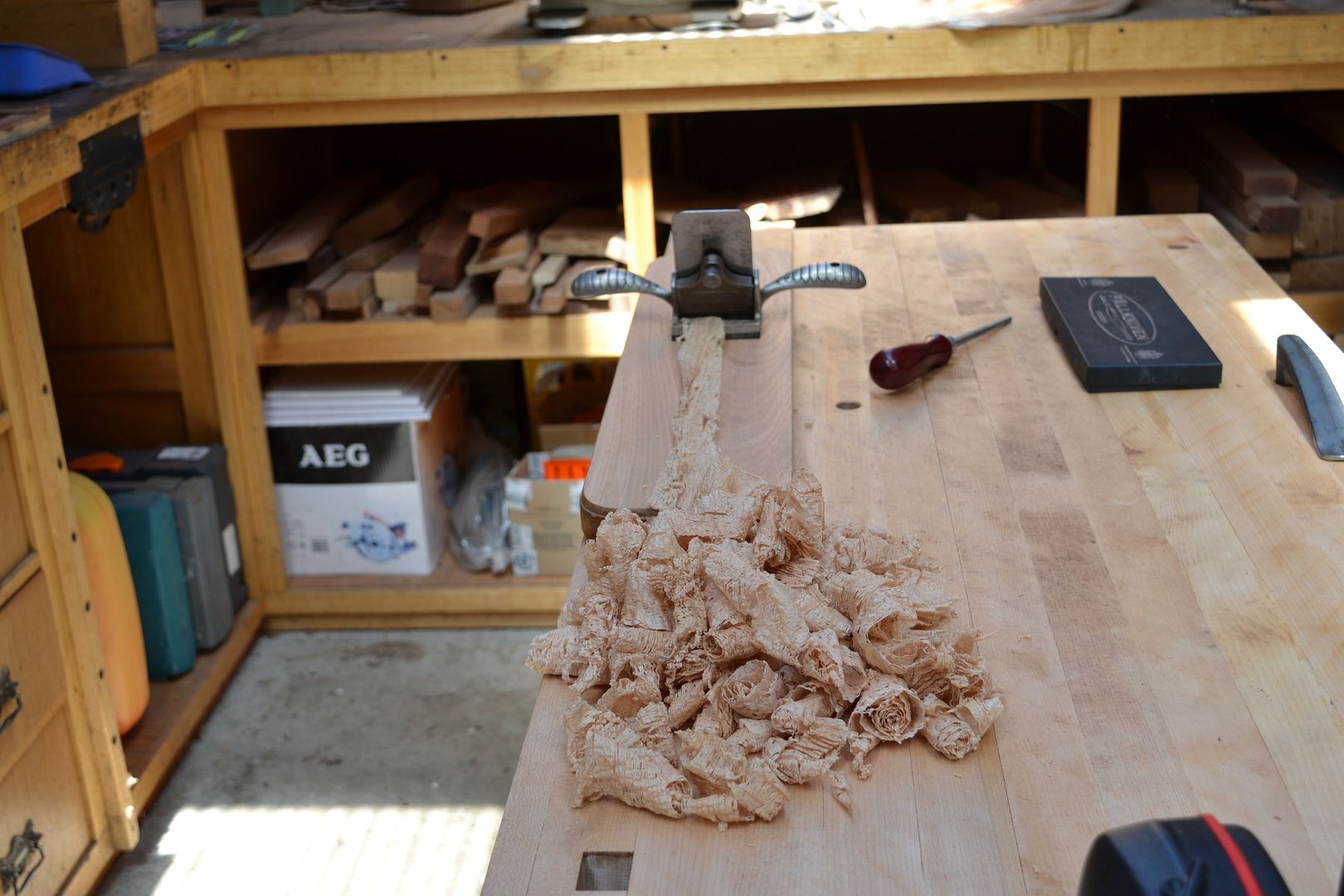
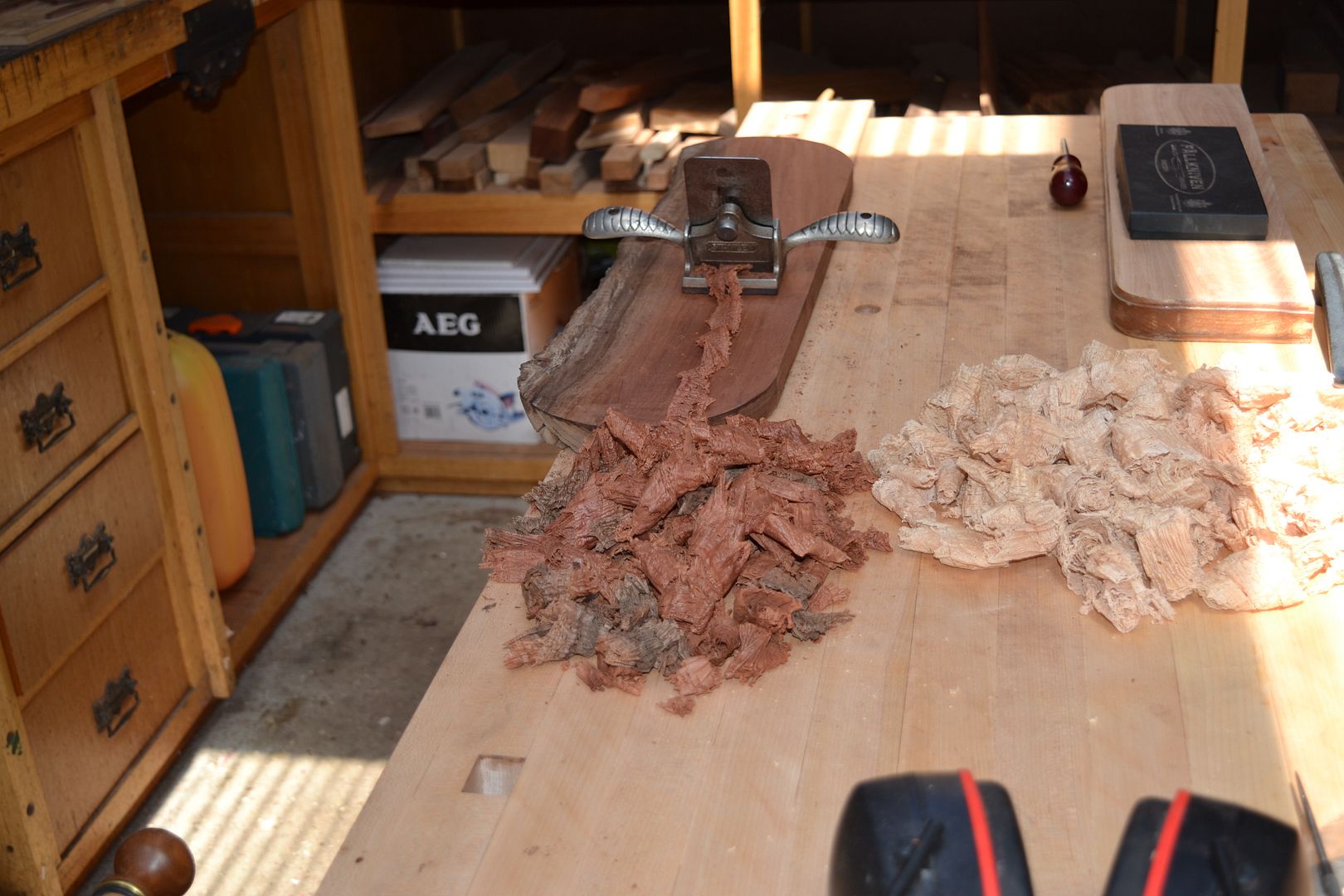
While all of the methods might be different (I'm just holding a burnisher around 20 degrees shy of 90), they generally do the same thing - turn a burr to the appropriate effective angle. You can do it a million ways as long as the result is the same.
There is a whole long discussion about the size of the burr, turning it small to start and refreshing it as larger each time if using a card scraper, etc, but I avoided that above because I don't think people like to "go deep" on that sort of thing like I do.
Agree on the flex - it does allow you to narrow the shaving, but that can be a pitfall if it's used too heavily (it will leave evidence on the surface whereas an unflexed blade will usually leave a pretty even surface if it's not overdone in one spot). I avoided that above, too. It's the kind of discussion that can only be had with a group of people who have already made mistakes with a scraper - most others will complain that it's too many details.
I've been working in a scraper vacuum (except for floors) for most of the last five years, though, so this is only what I recall from trying to master the 112, 212 and 80. I liked the 212 the best, but it can also scallop due to the narrow width, and the only affordable version of the 212 is LN's (affordable being a relative term). Woe be to the person who allows a panel to sit overnight through a temperature change, only to try to do the final surface prep with a 212. If a board as cupped, it will be a difficult and sweaty session if the board isn't re-planed.
There is a whole long discussion about the size of the burr, turning it small to start and refreshing it as larger each time if using a card scraper, etc, but I avoided that above because I don't think people like to "go deep" on that sort of thing like I do.
Agree on the flex - it does allow you to narrow the shaving, but that can be a pitfall if it's used too heavily (it will leave evidence on the surface whereas an unflexed blade will usually leave a pretty even surface if it's not overdone in one spot). I avoided that above, too. It's the kind of discussion that can only be had with a group of people who have already made mistakes with a scraper - most others will complain that it's too many details.
I've been working in a scraper vacuum (except for floors) for most of the last five years, though, so this is only what I recall from trying to master the 112, 212 and 80. I liked the 212 the best, but it can also scallop due to the narrow width, and the only affordable version of the 212 is LN's (affordable being a relative term). Woe be to the person who allows a panel to sit overnight through a temperature change, only to try to do the final surface prep with a 212. If a board as cupped, it will be a difficult and sweaty session if the board isn't re-planed.
swagman
Established Member
The following is the process i have settled on to form a hooked edge on my Stanley #81 Scraper Plane.
Others will recommend that you should continually remove the wire edged formed on the non bevel side of the scraper blade prior to turning the hooked edge with the burnisher. I would recommend you take the time to experiment with all the options available, and choose a method that will best work for you.
Stewie;
A 60 degree flat bevel is filed along the cutting edge, and then checked against a straight edge.
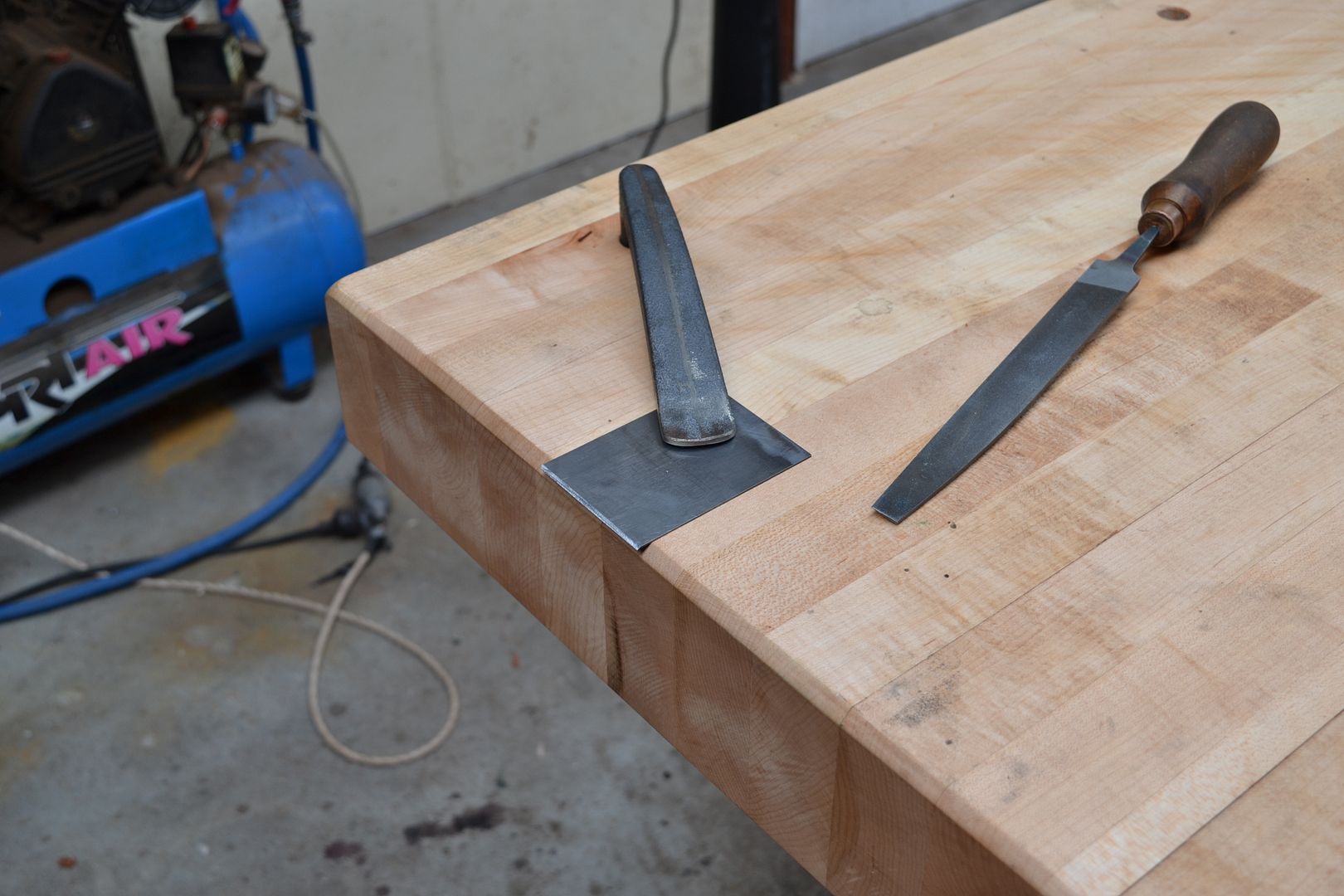
The wire edge formed on the non bevel side of the cutting edge during filing is removed on a sharpening stone. The blade is then held upright at 90 degrees to the sharpening stone and the edge is jointed to form an exact straight edge. The resulting wire edge on the non bevel side of the cutting edge is again removed.
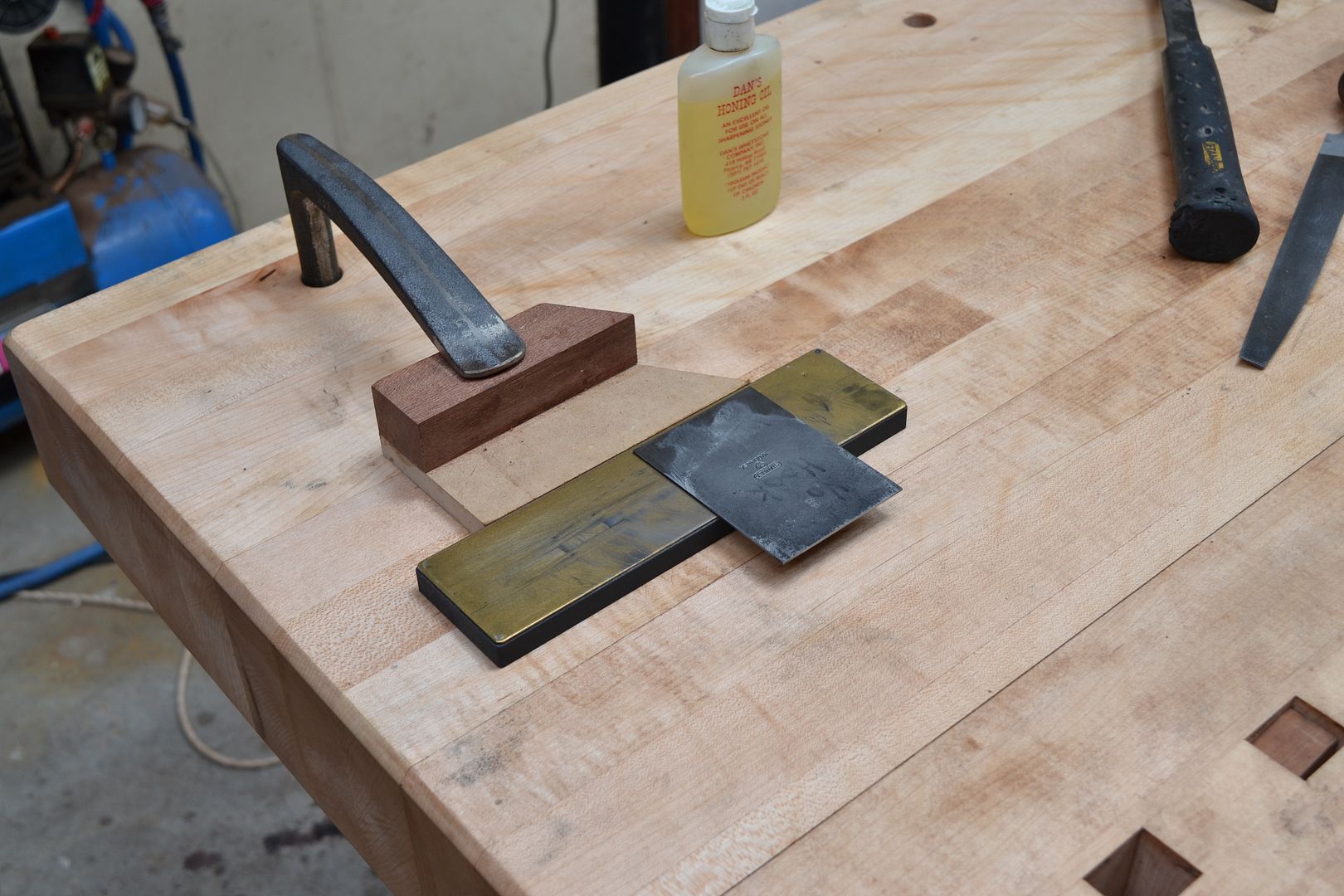
From this stage onwards, the wire edge that's formed during further stoning work is not removed, but is allowed to further increase in size prior to being turned over by the burnisher to create a hooked edge.
A fast cutting crystolon oil stone is the 1st stone to be used to form a slightly steeper secondary bevel. The wire edge formed is quite heavy to the touch and reaches across the full width of the blade.
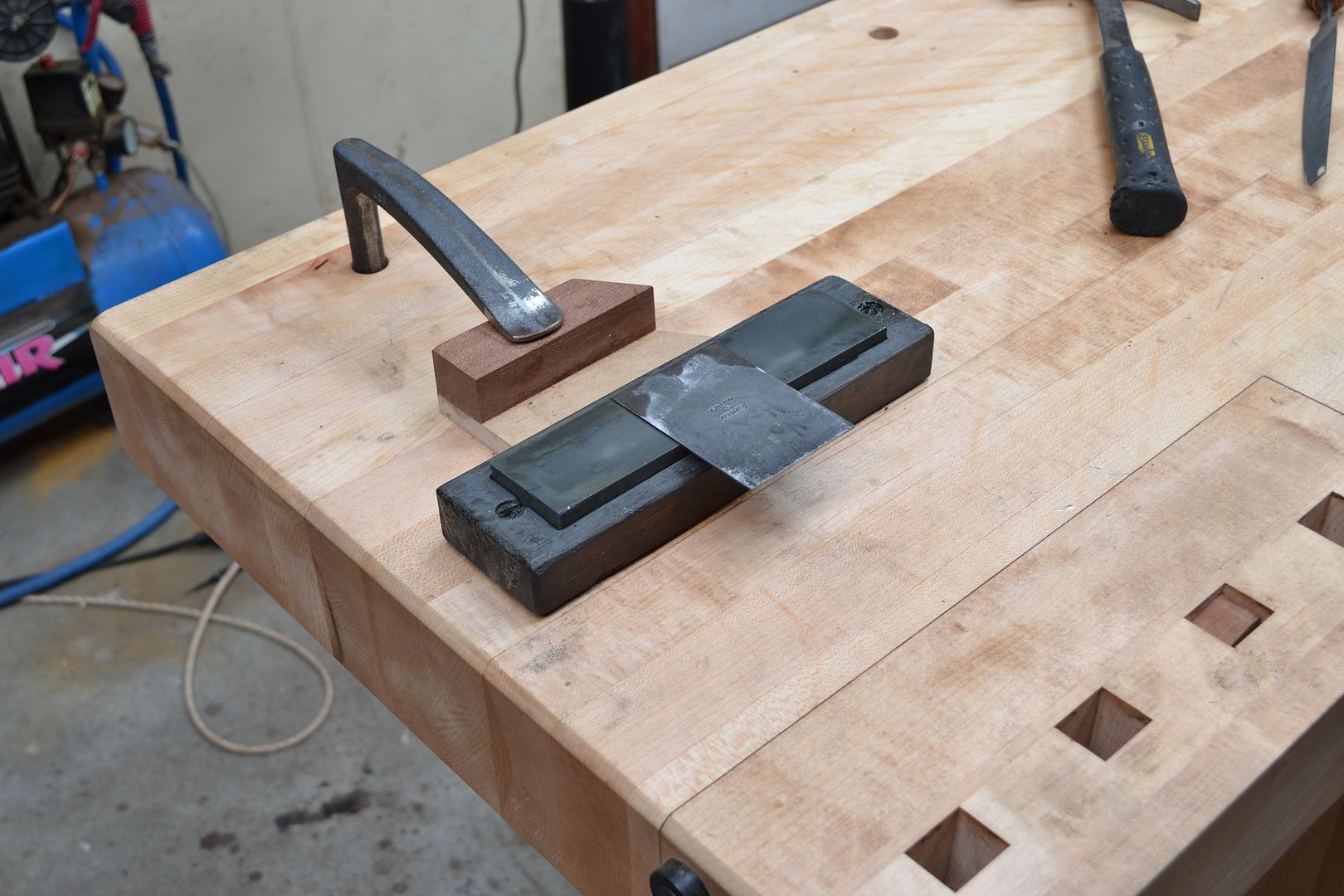
The secondary bevel is further worked on a finer grit stone to further increase the size of the wire edge.
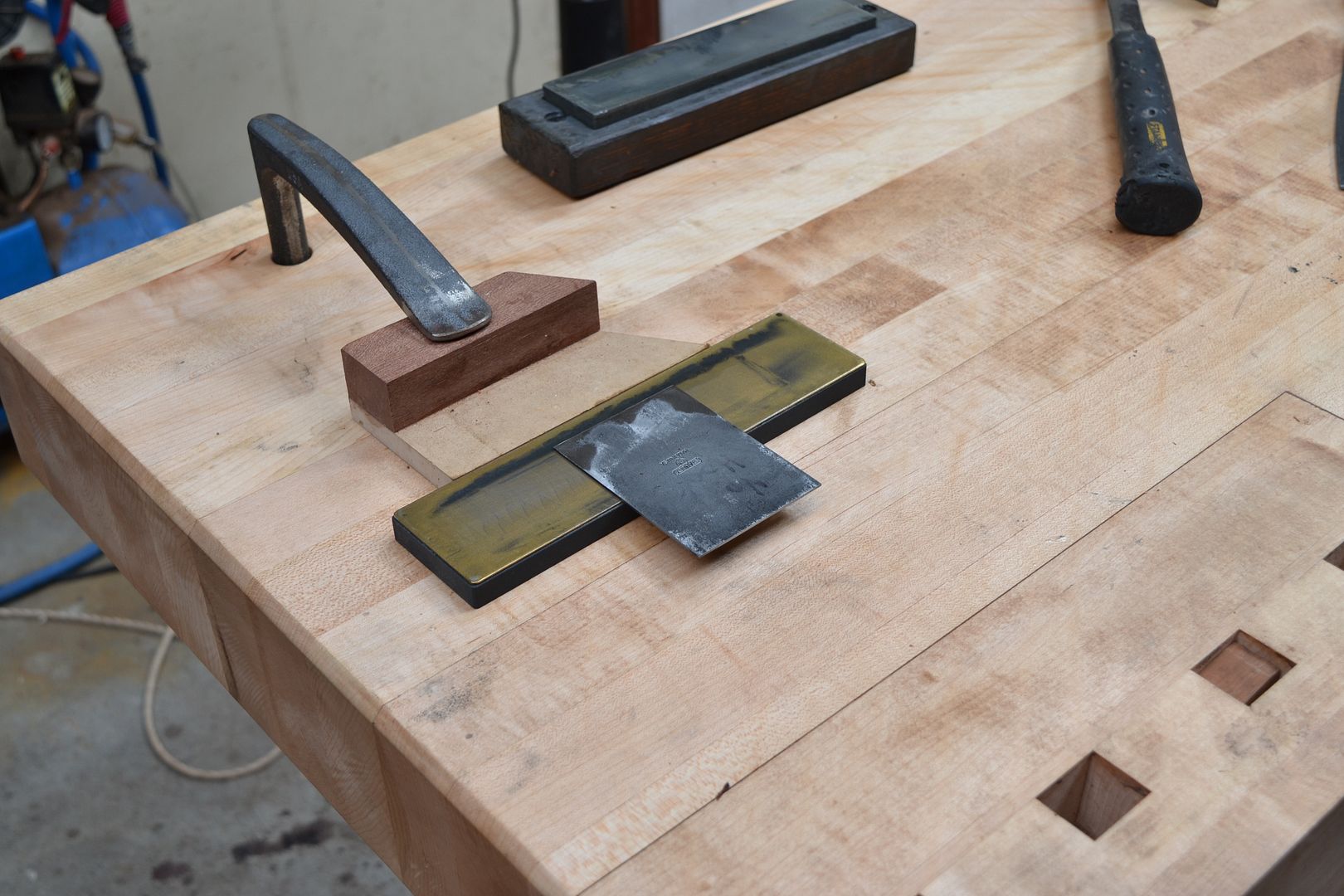
The process is again repeated on a final finer grit stone.
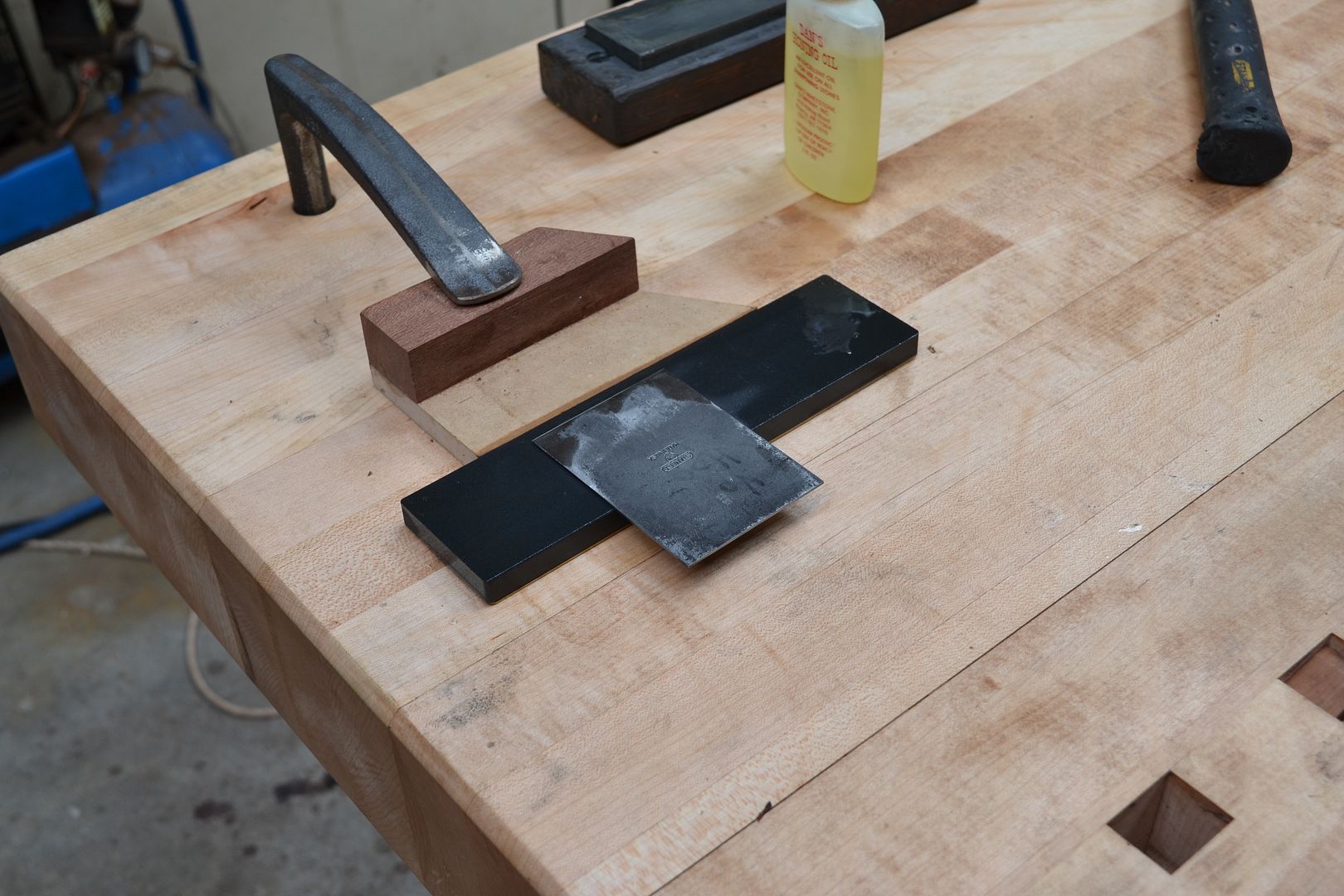
The cutting edge of the blade is then secured in a bench vise, with the burnisher held at 15 degrees to the primary face of the blade, The edge is then worked by the burnisher at that constant angle to form the hooked edge. Generally 2-3 full strokes are required.
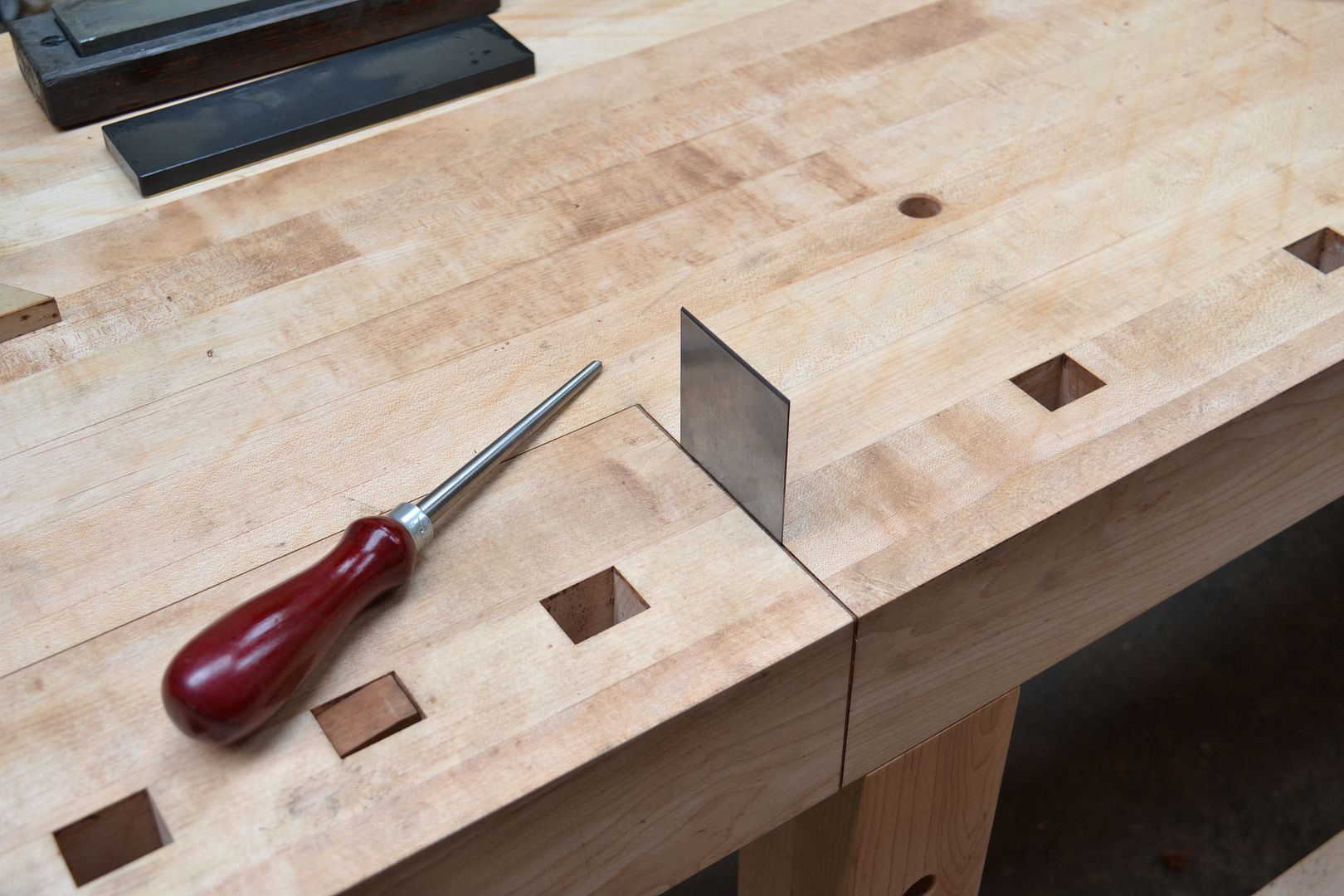
The scraper blade is now ready for a performance test.
The 1st lot of shavings were taken with the blade cambering screw disengaged. Moderate force is required to work each of the shaving due to the full width of cutting edge being in contact with the woods surface.
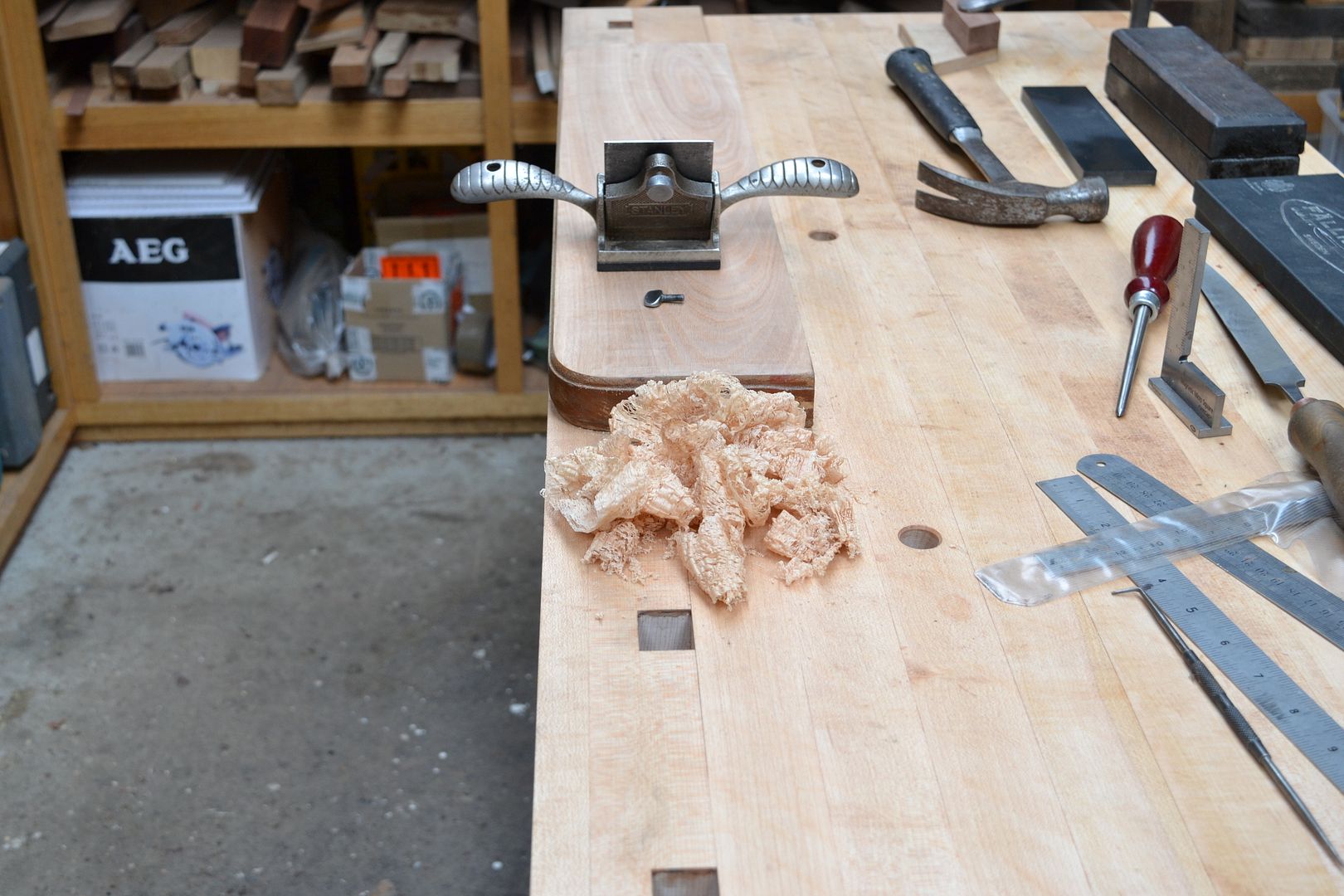
The next lot of shavings are with the blade cambering screw in service with a 1/2 turn. The force required is slightly less than the non cambered blade as less blade width is in direct contact with the wood surface.
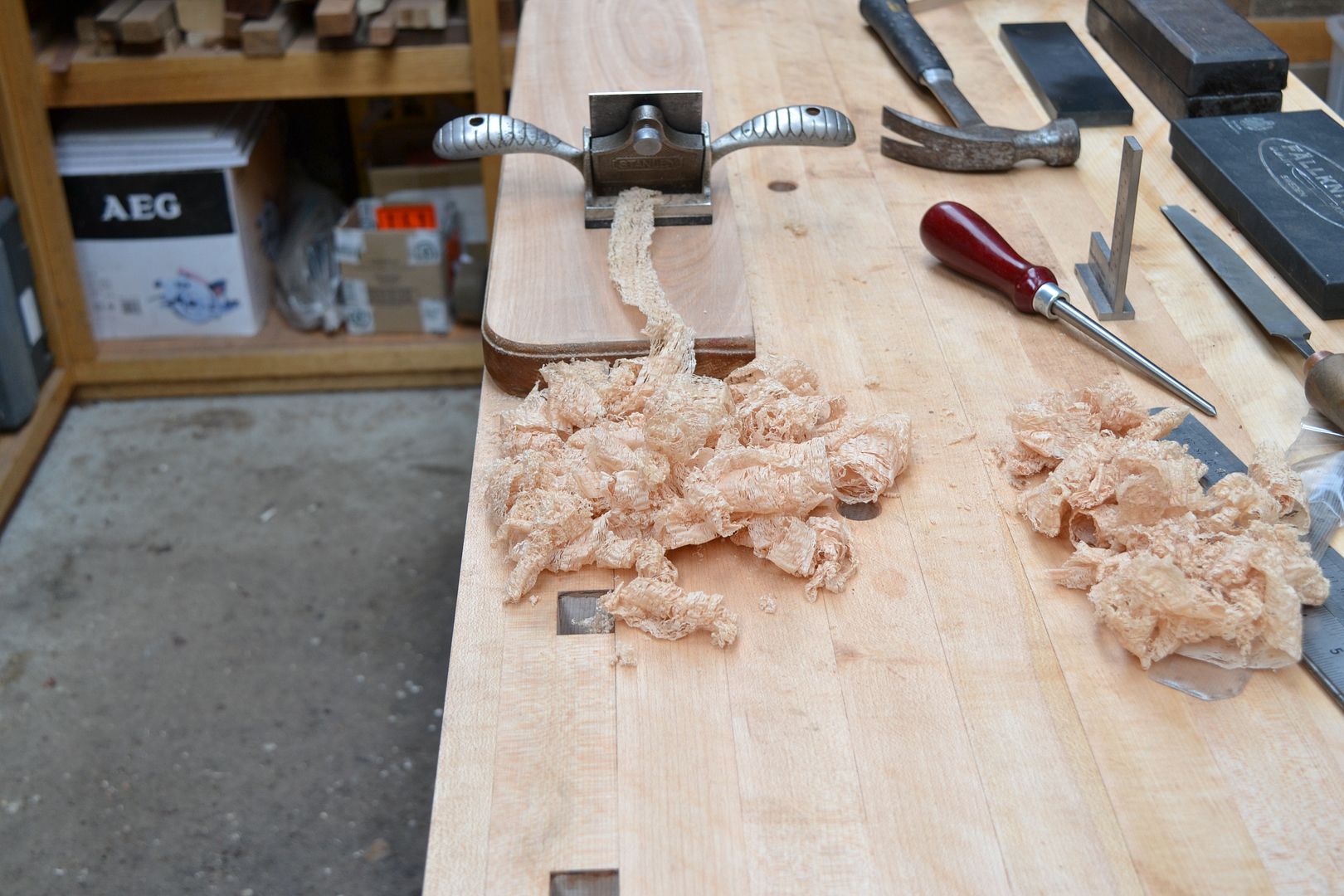
The final shavings were taken with a full turn of the cambering screw. The force required is slightly less than that set with a 1/2 turn of camber.
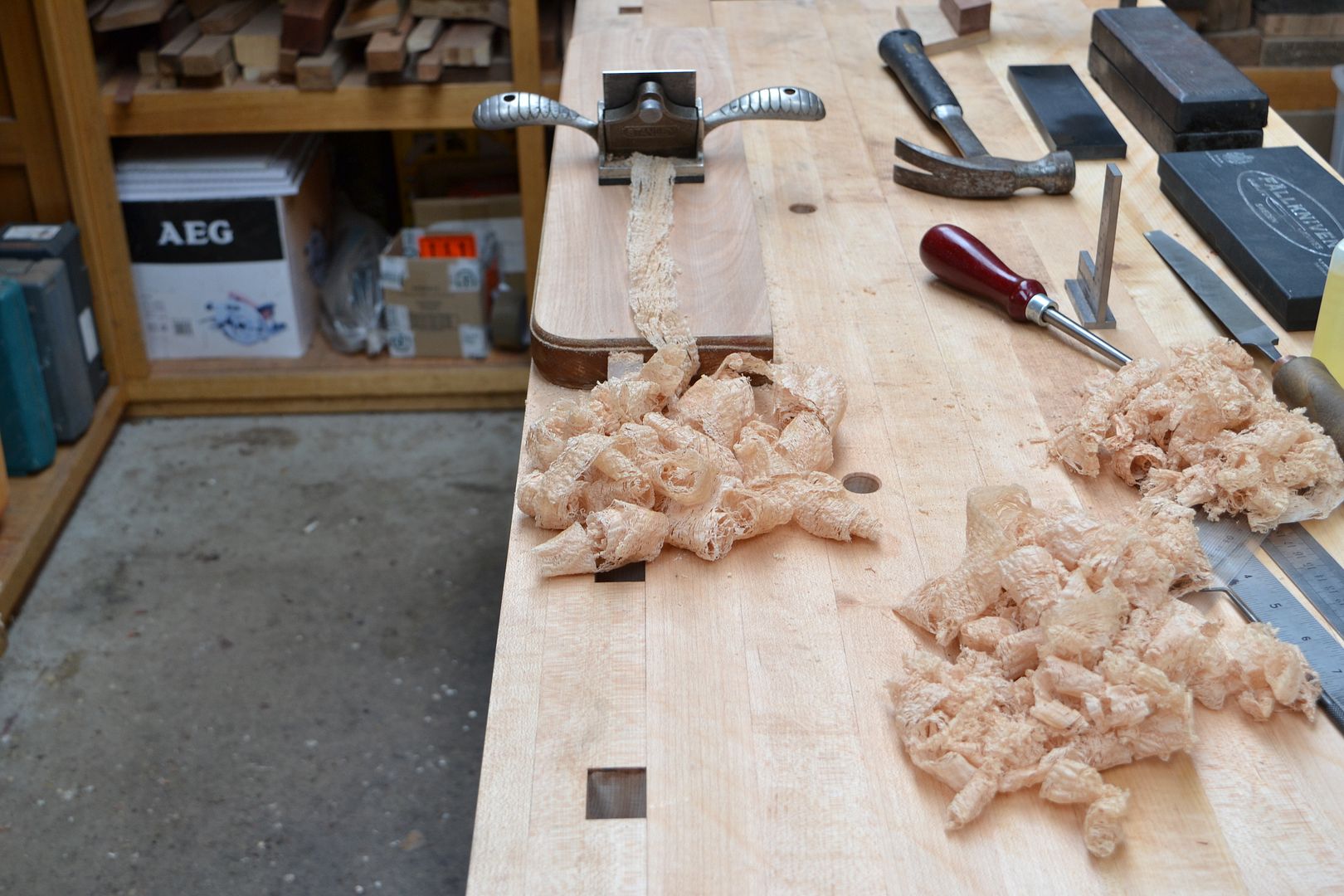
Others will recommend that you should continually remove the wire edged formed on the non bevel side of the scraper blade prior to turning the hooked edge with the burnisher. I would recommend you take the time to experiment with all the options available, and choose a method that will best work for you.
Stewie;
A 60 degree flat bevel is filed along the cutting edge, and then checked against a straight edge.

The wire edge formed on the non bevel side of the cutting edge during filing is removed on a sharpening stone. The blade is then held upright at 90 degrees to the sharpening stone and the edge is jointed to form an exact straight edge. The resulting wire edge on the non bevel side of the cutting edge is again removed.

From this stage onwards, the wire edge that's formed during further stoning work is not removed, but is allowed to further increase in size prior to being turned over by the burnisher to create a hooked edge.
A fast cutting crystolon oil stone is the 1st stone to be used to form a slightly steeper secondary bevel. The wire edge formed is quite heavy to the touch and reaches across the full width of the blade.

The secondary bevel is further worked on a finer grit stone to further increase the size of the wire edge.

The process is again repeated on a final finer grit stone.

The cutting edge of the blade is then secured in a bench vise, with the burnisher held at 15 degrees to the primary face of the blade, The edge is then worked by the burnisher at that constant angle to form the hooked edge. Generally 2-3 full strokes are required.

The scraper blade is now ready for a performance test.
The 1st lot of shavings were taken with the blade cambering screw disengaged. Moderate force is required to work each of the shaving due to the full width of cutting edge being in contact with the woods surface.

The next lot of shavings are with the blade cambering screw in service with a 1/2 turn. The force required is slightly less than the non cambered blade as less blade width is in direct contact with the wood surface.

The final shavings were taken with a full turn of the cambering screw. The force required is slightly less than that set with a 1/2 turn of camber.

Bodgers
Established Member
Anyone had issues with the Axminster Rider No. 80 with having to regrind the bevel to 45 degrees? I read sir Paul was not impressed with it as it was set to 30...
I might look for a used 81 if the Rider isn't up to snuff.
Sent from my iPad using Tapatalk
I might look for a used 81 if the Rider isn't up to snuff.
Sent from my iPad using Tapatalk
thetyreman
Established Member
Bodgers":hfu3e63z said:Anyone had issues with the Axminster Rider No. 80 with having to regrind the bevel to 45 degrees? I read sir Paul was not impressed with it as it was set to 30...
I might look for a used 81 if the Rider isn't up to snuff.
Sent from my iPad using Tapatalk
I doubt the axminster one is any good you'll be wasting your time and money sorting it out, regrinding the blade should not be an option. I'd go with the veritas cabinet scraper, they aren't that much more than the vintage ones with what they go for now
Very nice Stewie,,, love the bench too.
thetyreman":3pqo08i5 said:Bodgers":3pqo08i5 said:Anyone had issues with the Axminster Rider No. 80 with having to regrind the bevel to 45 degrees? I read sir Paul was not impressed with it as it was set to 30...
I might look for a used 81 if the Rider isn't up to snuff.
Sent from my iPad using Tapatalk
I doubt the axminster one is any good you'll be wasting your time and money sorting it out, regrinding the blade should not be an option. I'd go with the veritas cabinet scraper, they aren't that much more than the vintage ones with what they go for now
Does anybody know someone who uses one on a regular basis for finishing? I think I've had four of them, and while it's interesting to learn to set them up, they're always more time and less good at the edges than a common stanley plane.
patrickjchase
Established Member
D_W":1ex661qt said:Does anybody know someone who uses one on a regular basis for finishing? I think I've had four of them, and while it's interesting to learn to set them up, they're always more time and less good at the edges than a common stanley plane.
By "one" are you referring to 80-style cabinet scrapers?
Like you I prefer planes whenever the desired cutting geometry is viable in both types of tool. For example, the picture I posted in the other thread showed a scraper configured with the chip-breaking face set back ~0.004" from the cutting edge. That's a fairly easy geometry to obtain from a separate iron + cap-iron in a smoothing plane, so IMO there's little point in using a scraper for that if you've learned to use a double iron. The scraper's iron is softer to start, and burnishing always carries some risk of edge damage, so the net of it is that the plane delivers cleaner results. I set the burr the way I did in that picture to make it easier to image and because it's an appropriate configuration for a "heavy" tool like the 112, not because it's something I use routinely.
I do use scrapers when I want to do very light work with a very small burr, but I use card scrapers for that rather than scraping planes or cabinet scrapers.
custard
Established Member
D_W":1svtoxfq said:Does anybody know someone who uses one on a regular basis for finishing?
You ask a good question.
I think scraping falls into that category of woodworking techniques that used to be more widely used a generation ago than it is now. Consequently scraping has far greater prominence in the classic woodworking texts than it actually enjoys in modern workshops, or at least in the ones I've seen.
The quality of affordable abrasive papers is much higher than it was even twenty years ago. Throw in the fact that orbital sanders have also improved by leaps and bounds and it's easy to see why furniture makers today tend to regard scraping as a more specialised technique for occasional use, rather than a standard technique that gets used on a daily basis. Personally I'll use a card scraper for flushing down inlay, cleaning up internal curves, or stripping off old finishes; and occasionally I'll use a scraper plane on saw cut veneer that needs a lot of clean up work. But I'll often go months at a stretch without picking up either.
Thanks, Custard. Specifically, I meant that once you learn to plane (even though doing such a thing as final surface work may no longer be widely done), planing and using a card scraper is far more economical time-wise than using a #80, and the results are generally better.
David C
In Memorium
In my experience, scraper planes are indispensable for cleaning up veneered surfaces.
This is the task that virtually nothing else will do satisfactorily.
David Charlesworth
This is the task that virtually nothing else will do satisfactorily.
David Charlesworth
David C":yzrutos7 said:In my experience, scraper planes are indispensable for cleaning up veneered surfaces.
This is the task that virtually nothing else will do satisfactorily.
David Charlesworth
That's the one situation that stood out in the back of my head - veneering. It's sort of like the toothed blade revival (a little bit different, but in terms of how common toothed blades were) - toothed planes were used to prepare veneer surface for glue IIRC (I'm not an expert on them), but now discussed as a tearout mitigating plane for surfacing (another tool that is a penalty for not learning to use a cap iron).
I figured the #80 must've been so popular due to the volume of factory/production veneered furniture 100 years ago. But you see them used very little now.
In terms of common solid wood work that we do (table tops, preparing panel surfaces after glue-up, etc), a scraper plane is pretty difficult to justify if you have a stack of work to do.
If it's low quality production work, then both are pretty hard to justify compared to a wide belt sander or a progressive drum sander with increasing grit on each drum. But, we're not aiming to do that kind of work.
I have done very minimal veneer work, I'll admit. Probably 5 square feet total in a decade, and in most of that, i sawed the veneer so that I could work it like solid stock.
patrickjchase":3g5v4k4u said:D_W":3g5v4k4u said:Does anybody know someone who uses one on a regular basis for finishing? I think I've had four of them, and while it's interesting to learn to set them up, they're always more time and less good at the edges than a common stanley plane.
By "one" are you referring to 80-style cabinet scrapers?
Like you I prefer planes whenever the desired cutting geometry is viable in both types of tool. For example, the picture I posted in the other thread showed a scraper configured with the chip-breaking face set back ~0.004" from the cutting edge. That's a fairly easy geometry to obtain from a separate iron + cap-iron in a smoothing plane, so IMO there's little point in using a scraper for that if you've learned to use a double iron. The scraper's iron is softer to start, and burnishing always carries some risk of edge damage, so the net of it is that the plane delivers cleaner results. I set the burr the way I did in that picture to make it easier to image and because it's an appropriate configuration for a "heavy" tool like the 112, not because it's something I use routinely.
I do use scrapers when I want to do very light work with a very small burr, but I use card scrapers for that rather than scraping planes or cabinet scrapers.
Could be opened up to 112s or other tools that are described by patrick leach as the next coming. They seem like a solution to someone having difficulty with tearout, but I'm reminded by a friend who has one and who just discovered the world of bevel up planes after having difficulty setting the cap iron. Having a BUS in hand cutting an effective 60 degrees pretty much eliminates the chance of his scraper ever being used. He did learn to set the scraper plane and have it work well, but grab a stack of wood and do half with a plane and half with a #112 and you'll use the plane for the entire stack the second time.
Or to be more frank, I think scraper planes and cabinet scrapers are mostly used these days to see if you can learn to roll a burr and then have a fun time with test pieces where you don't care about the edges. I learned the same thing, and used both on a few projects (in solid) before I realized that they were a waste of time compared to planing. I realized at the same time that the mujingfang HSS ironed 63 degree smoother is pretty much an answer to nothing. Slow to use, poor surface finish and dulls quickly (even though it's HSS) due to the bed angle - and it's ultra sensitive to depth of set due to the combination of the bed geometry (more depth per N units of iron advancement) and the hard to push 63 degree pitch.
swagman
Established Member
Or to be more frank, I think scraper planes and cabinet scrapers are mostly used these days to see if you can learn to roll a burr and then have a fun time with test pieces where you don't care about the edges.
David; was that comment aimed in my direction. :mrgreen:
Only so much as you're like the rest of us!
That's what I did (mastered rolling the burr and then didn't like the tool that much), and I found it immensely satisfying to learn the touch of rolling a good burr every time. But each time I went to use the 80 or 112, and though not the same thing, the Muji 63 degree plane - I ended up thinking "it can't take this much effort to smooth a surface".
It's good skill building for a card scraper, though, which will definitely see use.
(I found the LN 212 a little bit more practical for less than perfectly flat surfaces and without torturing edges, but it's narrow enough that it leaves scallops with all but the lightest cuts).
That's what I did (mastered rolling the burr and then didn't like the tool that much), and I found it immensely satisfying to learn the touch of rolling a good burr every time. But each time I went to use the 80 or 112, and though not the same thing, the Muji 63 degree plane - I ended up thinking "it can't take this much effort to smooth a surface".
It's good skill building for a card scraper, though, which will definitely see use.
(I found the LN 212 a little bit more practical for less than perfectly flat surfaces and without torturing edges, but it's narrow enough that it leaves scallops with all but the lightest cuts).
thetyreman
Established Member
talking of scraper planes, I fancy the miniature cabinet scraper plane by veritas, has anyone used this?
Similar threads
- Replies
- 10
- Views
- 969




